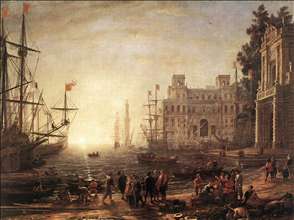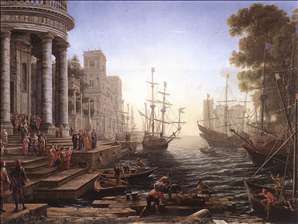Claude Lorrain, byname of Claude Gelle, French artist best known for, and one of the greatest masters of, ideal-landscape painting, an art form that seeks to present a view of nature more beautiful and harmonious than nature itself. The quality of that beauty is governed by classical concepts, and the landscape often contains classical ruins and pastoral figures in classical dress. The source of inspiration is the countryside around Rome - the Roman Campagna - a countryside haunted with remains and associations of antiquity. The practitioners of ideal landscape during the 17
th century, the key period of its development, were artists of many nationalities congregated in Rome. Later, the form spread to other countries. Claude, whose special contribution was the poetic rendering of light, was particularly influential, not only during his lifetime but, especially in England, from the mid-18
th to the mid-19
th century.
Life and works
Claude Lorrain, usually called simply Claude in English, was born of poor parents at Chamagne, a village in the then independent duchy of Lorraine. He received little schooling, and, according to his first biographer, Joachim von
Sandrart, was brought up to be a pastrycook. His parents seem to have died when he was 12 years old, and, within the next few years, he travelled south to Rome.
In Rome he was trained as an artist by Agostino
Tassi, a landscapist and the leading Italian painter of illusionistic architectural frescoes. At what stage and for how long he was apprenticed is uncertain, and, either before or during this period, Claude probably spent two years in Naples with Goffredo Wals, another pupil of Tassi. Tassi taught Claude the basic vocabulary of his art - landscapes and coast scenes with buildings and little figures - and gave him a lasting interest in perspective and, thus, in landscape painting.
In 1625, according to his second biographer, Filippo Baldinucci, Claude left Tassi and went back to Nancy, the capital of Lorraine, where he worked for a year as assistant to Claude
Deruet on some frescoes (since destroyed) in the Carmelite church. But, in the winter of 1626-27, Claude returned to Rome and settled there permanently. He never married, but he had a daughter, Agnese (1653-c. 1713), who lived in his house; also staying with him were a pupil, Giovanni Domenico Desiderii, from 1633 to c. 1656, and two nephews, Jean from c. 1663 and Joseph from c. 1680. In 1633, to further his career, Claude joined the painters Academy of St. Luke.
Little is known of his personality. He took no part in public events and lived essentially for his work. In his early period he mixed with other artists, especially those who were of northern European origin like himself, but in his 40s he apparently became more solitary. He remained on good terms with the painter Nicolas
Poussin, another French master of the ideal landscape, yet there was hardly any artistic contact between them. Although ill-educated in the formal sense (both his spelling and counting were eccentric, and he wrote haltingly in French and Italian), Claude was not the ignorant peasant of legend. The subjects of his paintings show that he had an adequate knowledge of the Bible, Ovid s Metamorphoses, and the Aeneid. He had a special feeling for the country, but his mode of life was that of a bourgeois. Industrious, amiable, and shrewd, surrounded by his modest household, and keenly sought after as an artist, he pursued a successful career into old age and amassed a comfortable fortune.
No work by Claude survives from before 1627, and he probably did not take up landscape until after that date. His first dated work is Landscape with Cattle and Peasants. Painted in 1629, it hangs in the Philadelphia Museum of Art. Soon after, in the early 1630s, he rose to fame. He did this partly on the basis of two or three series of landscape frescoes (all but one, a small frieze in the Crescenzi palace at Rome, are now lost), but, according to Baldinucci, he achieved renown chiefly because of his skill in representing those conditions of nature which produce views of the sun, particularly on seawater and over rivers at dawn and evening. By about 1637 - with commissions from Pope Urban VIII, several cardinals, and Philip IV of Spain - Claude had become the leading landscape painter in Italy.
In 1635-36 he began the Liber Veritatis (Book of Truth; in the British Museum, London), a remarkable volume containing 195 drawings carefully copied by Claude after his own paintings, with particulars noted on the backs of the drawings indicating the patron for whom, or the place for which, the picture was destined, and, in the second half of the book, the date. Although most paintings executed before 1635 and a few executed afterward are not included, the Liber Veritatis was compiled throughout in chronological order and thus forms an invaluable record of Claude s artistic development, as well as revealing his circle of patrons. Undertaken, as he told Baldinucci, as a safeguard against forgery of his paintings, the book gradually became Claude s most precious possession and a work of art in itself; he may also have used it as a stock of motifs for new compositions.
Claude s patrons were international and predominantly aristocratic, the majority being French or Italian noblemen. He was a fastidious worker and an expensive artist. He always worked on commission, at first sometimes selling his paintings through agents, but later he negotiated directly with patrons, with whom he would agree as to the size, price, and subject. Initially a fast painter, his rate of production subsequently slowed down. His late works are often individually larger and were still more carefully executed. About 250 paintings by Claude, out of a total of perhaps 300, and more than 1,000 drawings have survived. He also produced 44 etchings.
Stylistic development
Although they are basically consistent in method and aim, Claude s paintings show a gradual stylistic evolution, and it is possible to distinguish the phases of his development. His early works, showing the influence of Tassi and of Dutch and Flemish artists, are busy, animated, and picturesque. They are full of charm and effects of surprise. His smaller pictures, painted on copper, reflect the spirit of the German artist Adam
Elsheimer, who had died in Rome in 1610. Occasionally Claude painted directly from nature during this period, although no examples have been certainly identified; his normal method of nature study was by means of drawings. A pattern common in the early paintings is a dark mass of foliage on one side in the foreground contrasted with a misty sunlit distance on the other. Herdsmen tending cattle or goats move out from beneath the trees or sit beside a stream (scarcely any of Claude s paintings at any time are without figures and animals).
Simultaneously Claude developed the traditional subject of a coastal scene with boats into a new type of picture: the seaport. This is an idealized harbour scene flanked on one or both sides with palaces, the latter often being adapted from actual ancient or contemporary buildings. Tall ships ride at anchor, recently arrived or preparing to depart. Light, however, is the key feature of the seaport pictures. Its source is often a visible sun just above the horizon, which Claude first introduced in 1634 in Harbour Scene and, in so doing, used the sun as the means of illuminating a whole picture for the first time in art. This use of light from the sky above the horizon, whether emanating directly from the sun or not, enforces another characteristic of Claude s paintings: recession in depth. Recession is further emphasized by subtle atmospheric perspective achieved through a gradual diminishing of the distinctness of outline and colour from the foreground to the background. The light is nearly always that of dawn or evening.
Beginning around 1640 Claude began to make his compositions more classical and monumental. The influence of contemporary Bolognese landscape painting, particularly the works of
Domenichino, replaces that of Tassi and the northerners. During this decade something like a formula establishes itself: tall trees on one side of the picture balanced by a classical ruin and smaller trees further back on the other; a foreground stage with figures; a winding river conducting the eye by stages through an open landscape to the horizon; and distant hills, often with a glimpse of the sea. The figures are not, as often before, in contemporary dress but are always represented in classical or biblical costume. Contrary to popular belief, virtually all of Claude s figures were painted by himself. Sometimes they are merely shepherds, but frequently they embody a subject from classical mythology or sacred history. The light is clearer than in paintings of the early or late periods. Spacious, tranquil compositions are drenched in an even light, as can be seen in Landscape: The Marriage of Isaac and Rebekah (also called The Mill), dated 1648.
The 1650s witness some still larger and more heroic paintings, including The Sermon on the Mount. In the middle of the following decade, Claude s style moved into its last phase, when some of his greatest masterpieces were produced. The colour range is restricted, and the tones become cool and silvery. The figures are strangely elongated and by conventional standards ill drawn. At the same time, the subjects define the mood and sometimes determine the composition of the landscape. The paintings of this period are solemn and mysterious and radiate a sublime poetic feeling. It was in this spirit that Claude painted his famous work The Enchanted Castle.
Achievement as a draftsman
Claude s drawings are as remarkable an achievement as his paintings. About half are studies from nature. Executed freely in chalk or pen and wash, they are much more spontaneous than his paintings or studio drawings and represent informal motifs - trees, ruins, waterfalls, parts of a riverbank, fields in sunlight - that Claude saw on his sketching expeditions in the Campagna. Many were executed in bound books, which have since been broken up. The studio drawings consist partly of preparatory designs for paintings - Claude prepared his work more carefully than any previous landscape artist - and partly of compositions created as ends in themselves.
Claude had only two students; nonetheless, his paintings influenced a number of Dutch painters who were in Rome during the late 1630s and 40s, and, in a broad sense, his influence can be seen even in the work of certain English landscape painters of the 19
th century.









